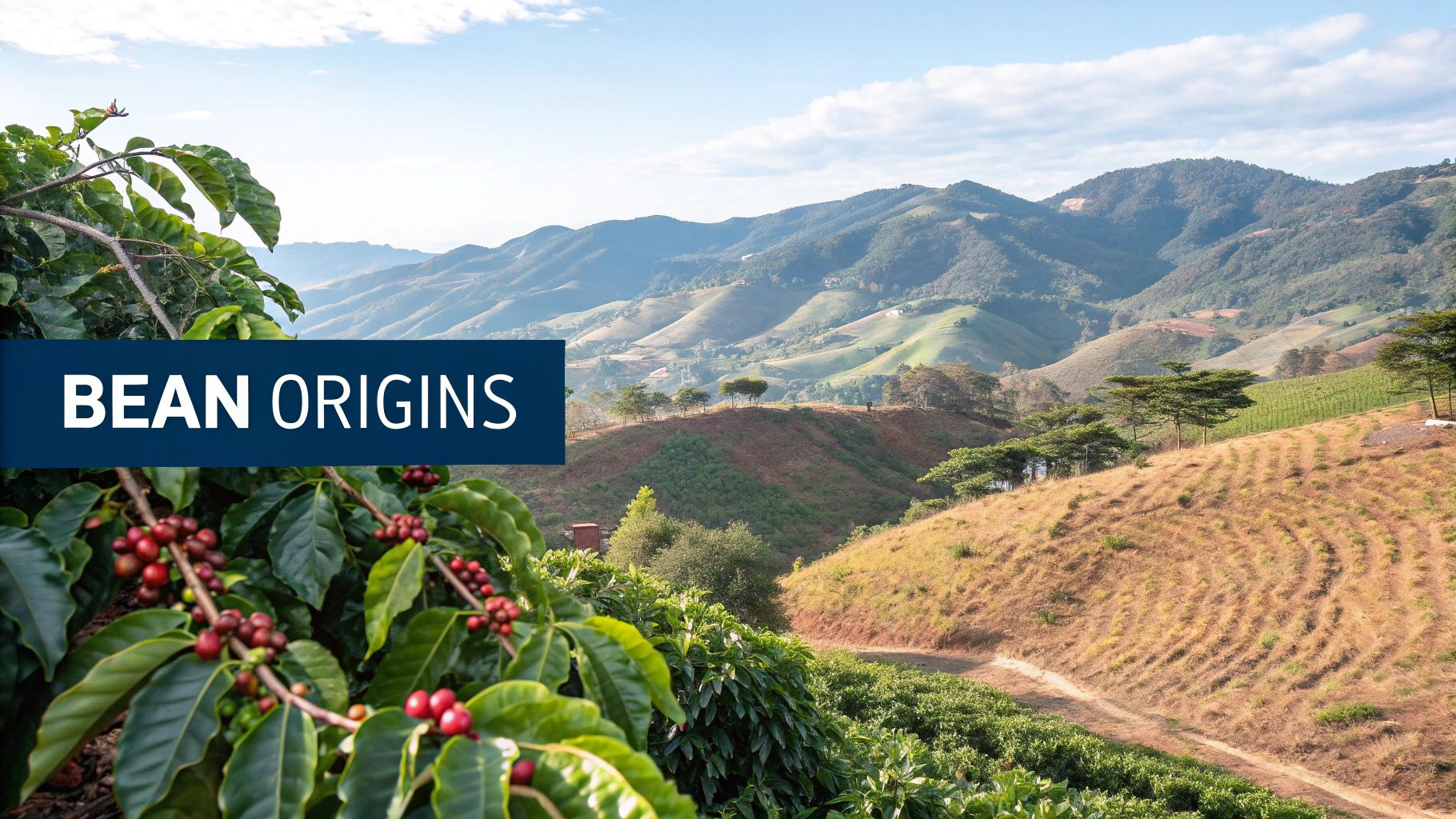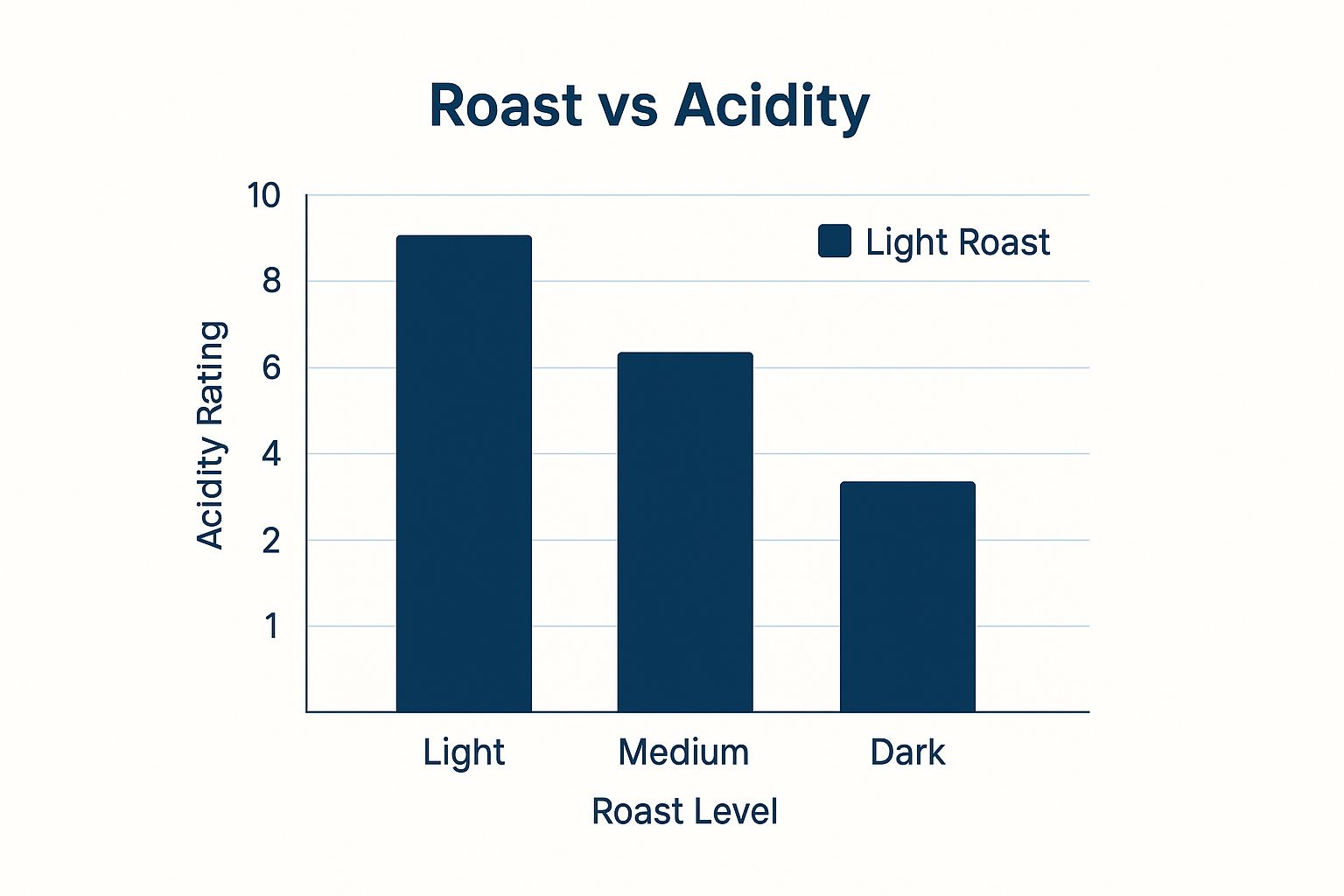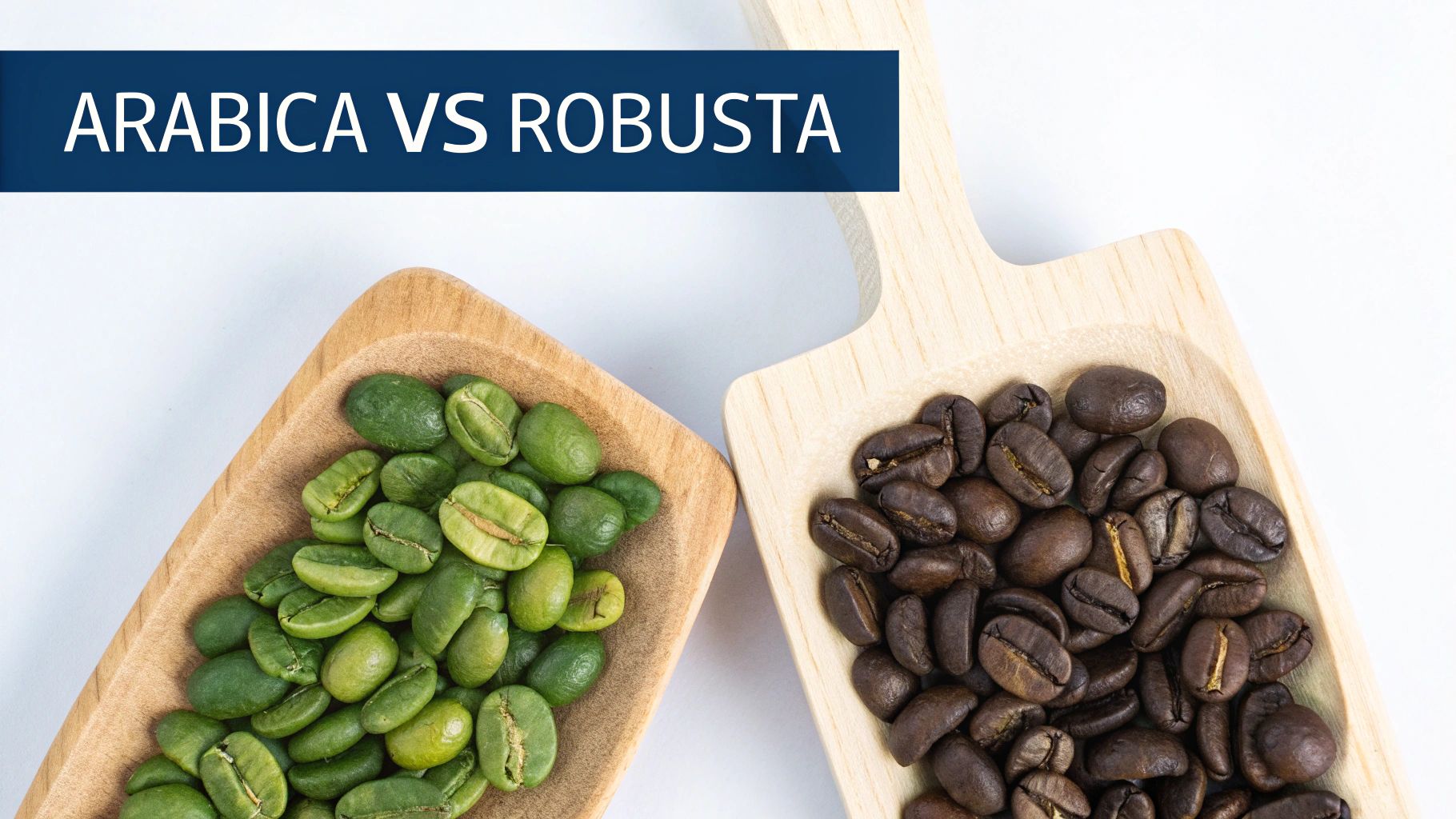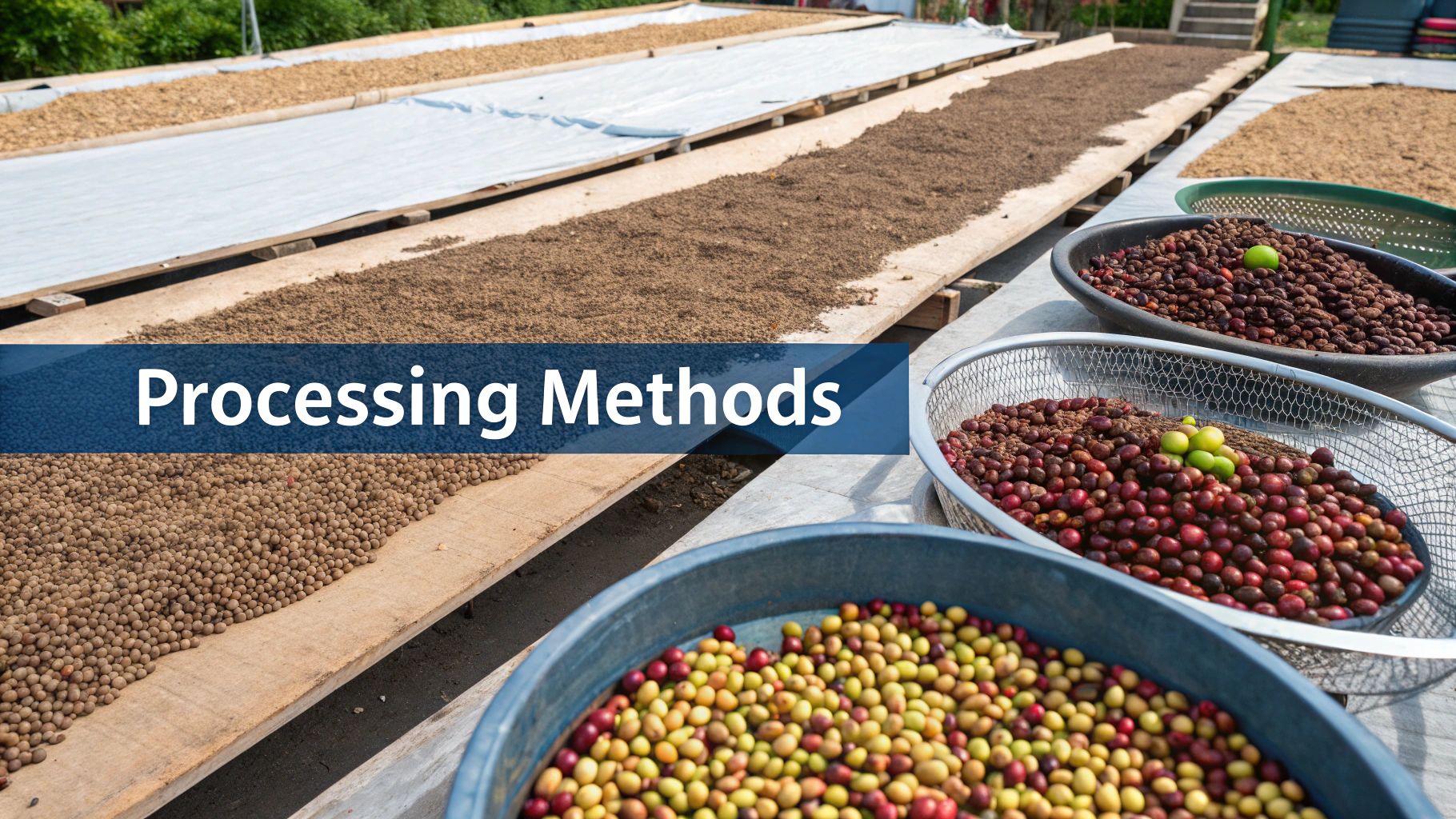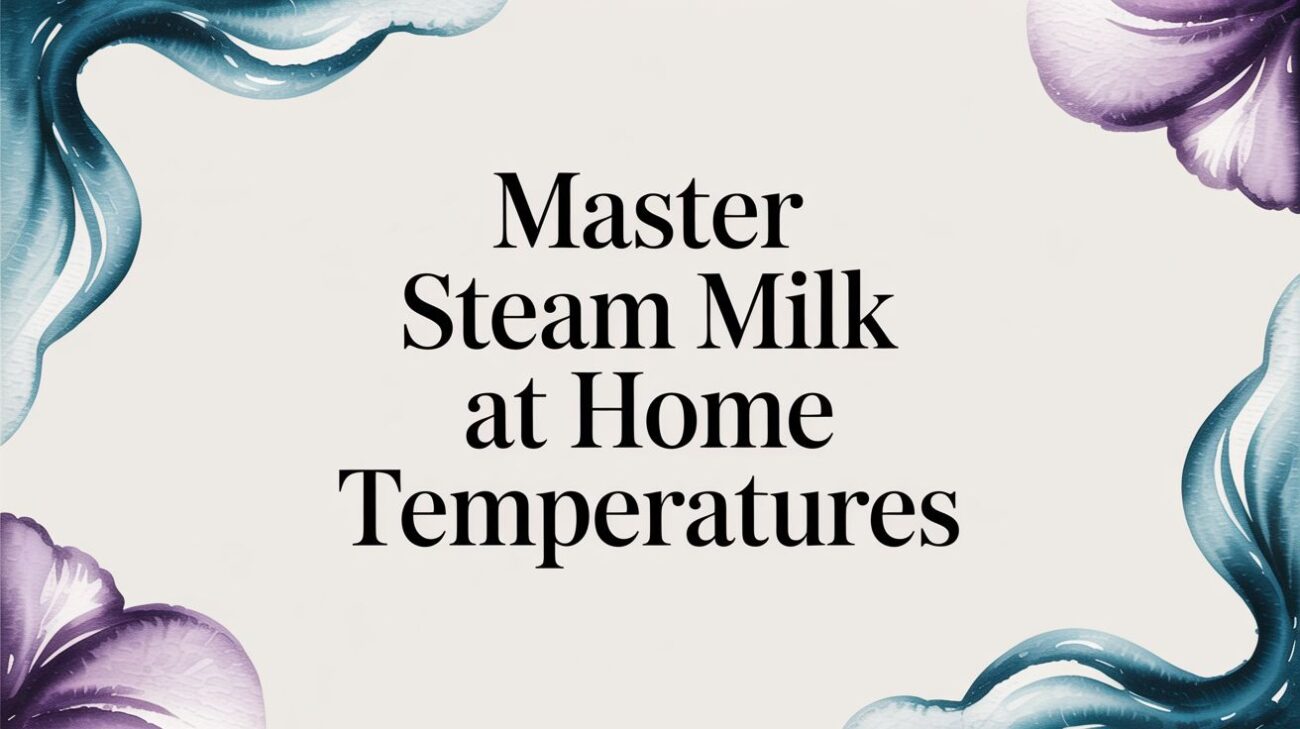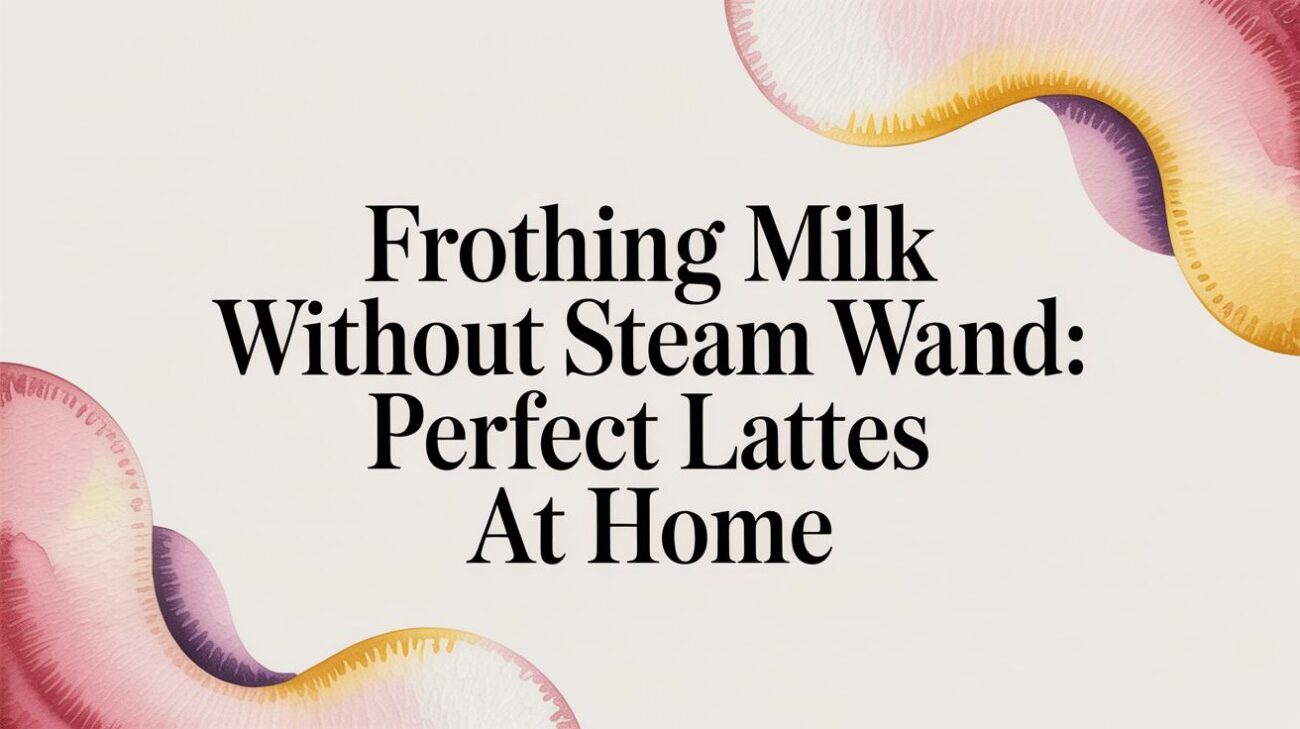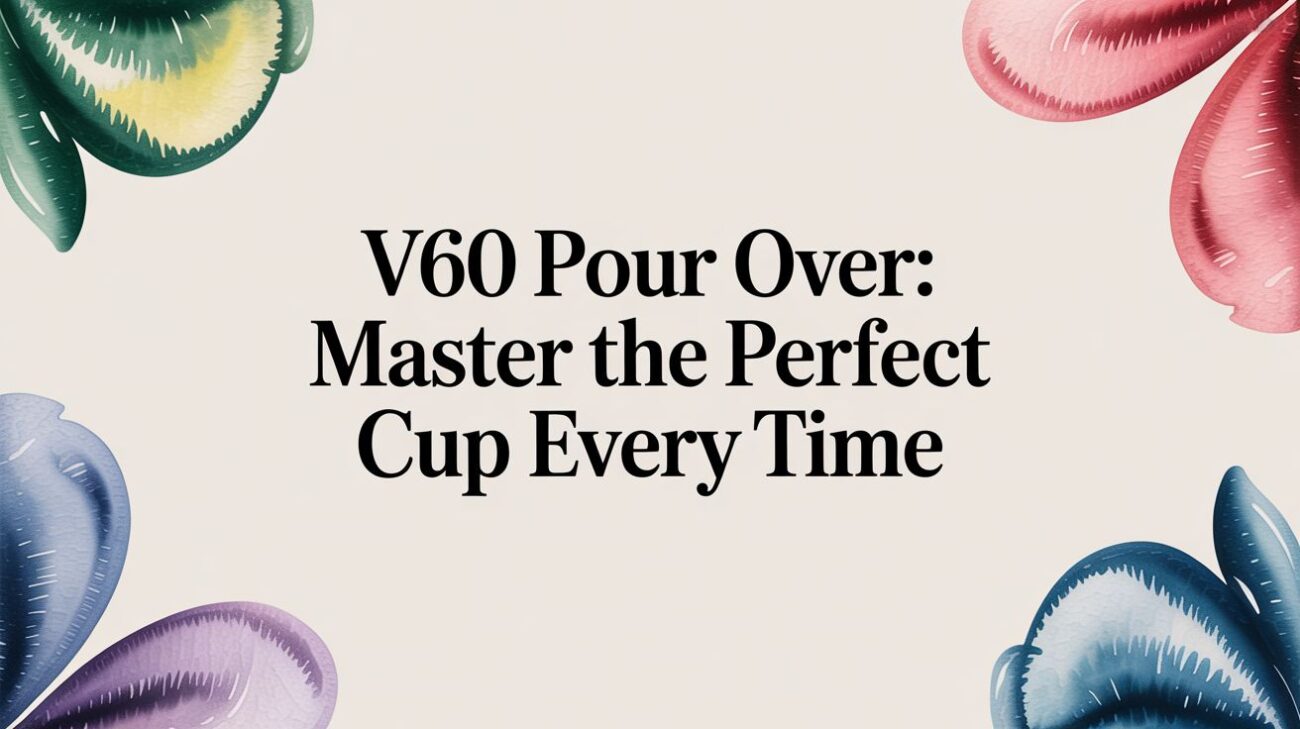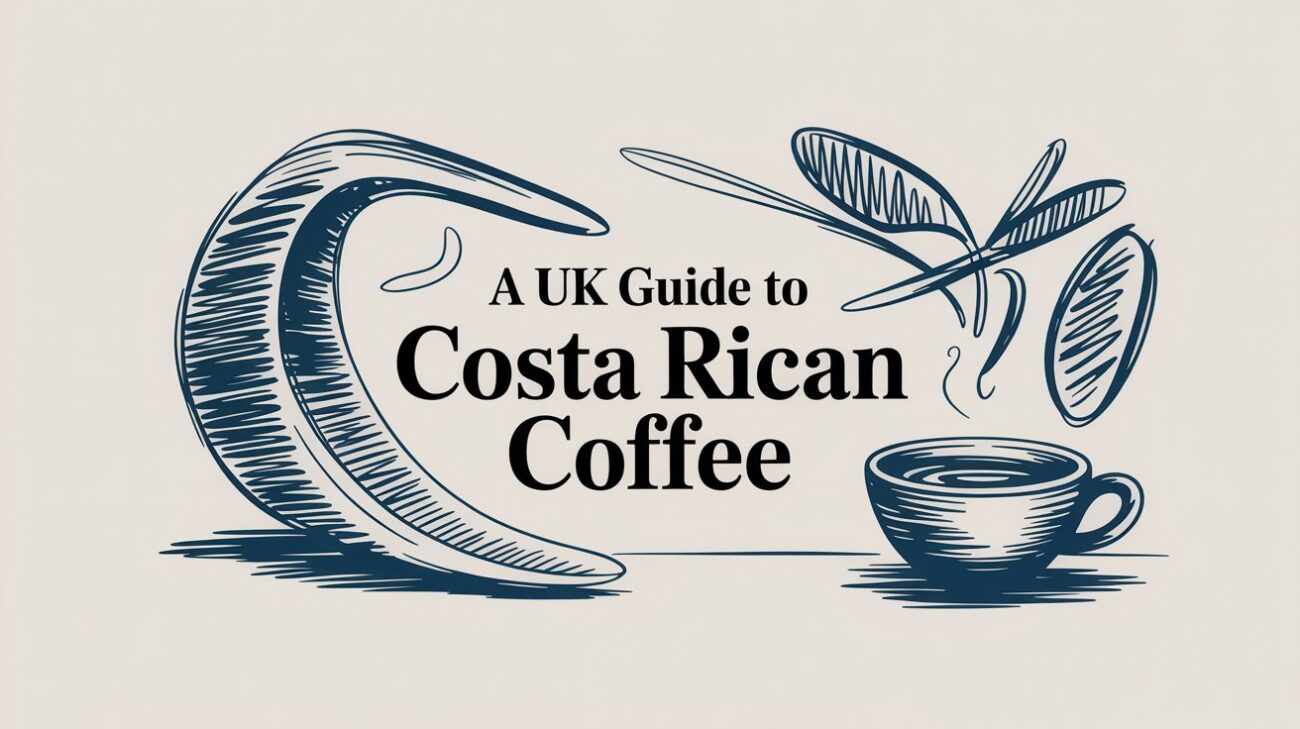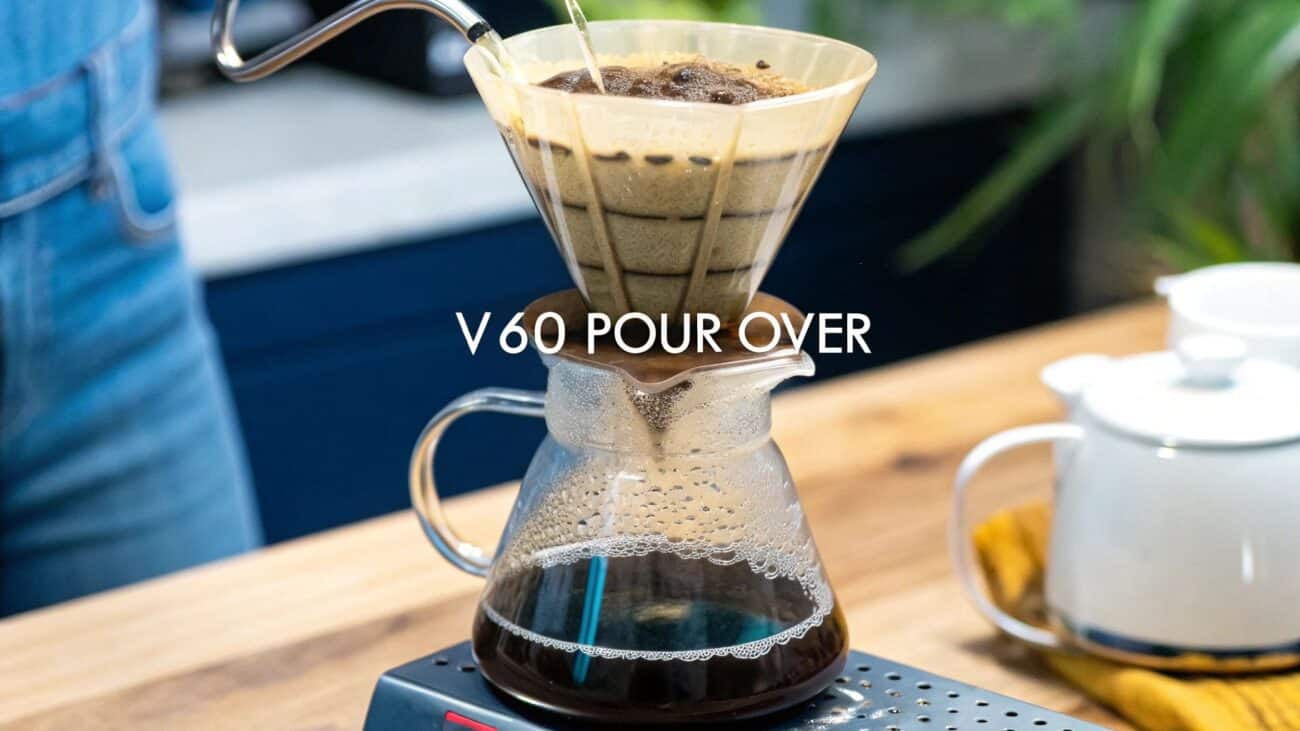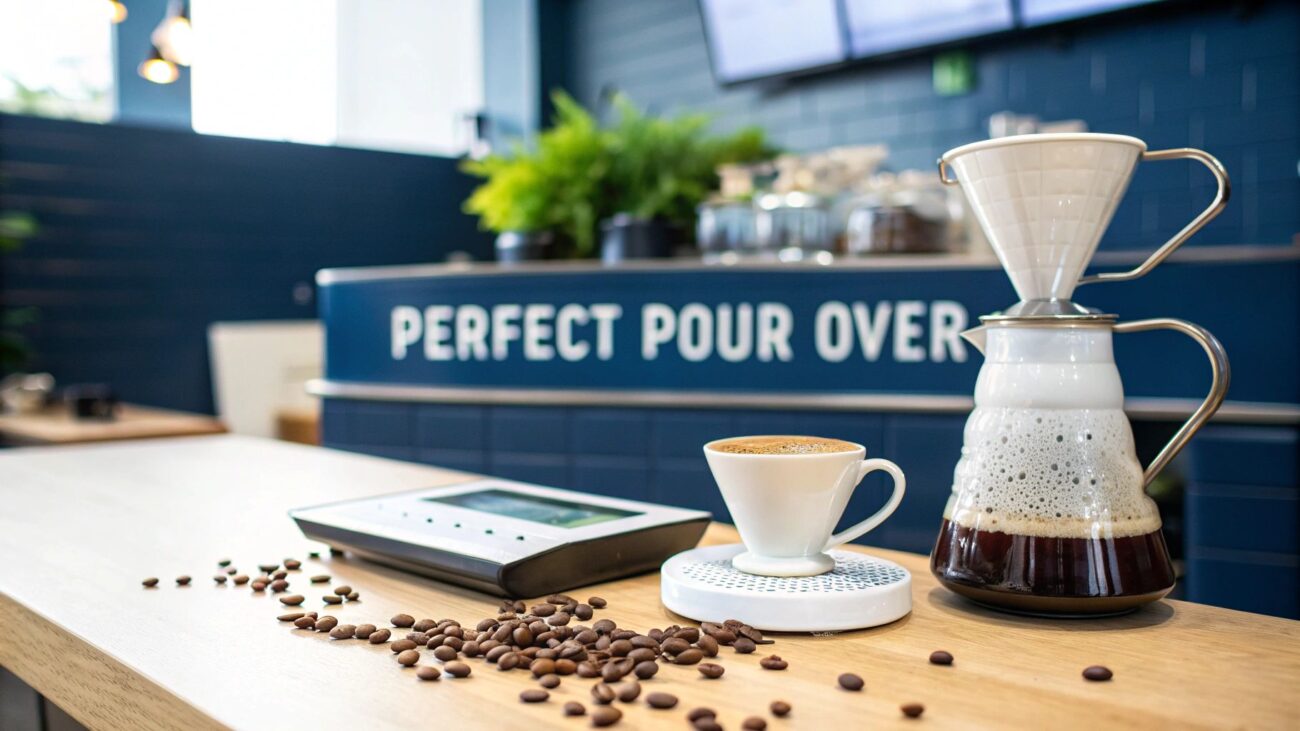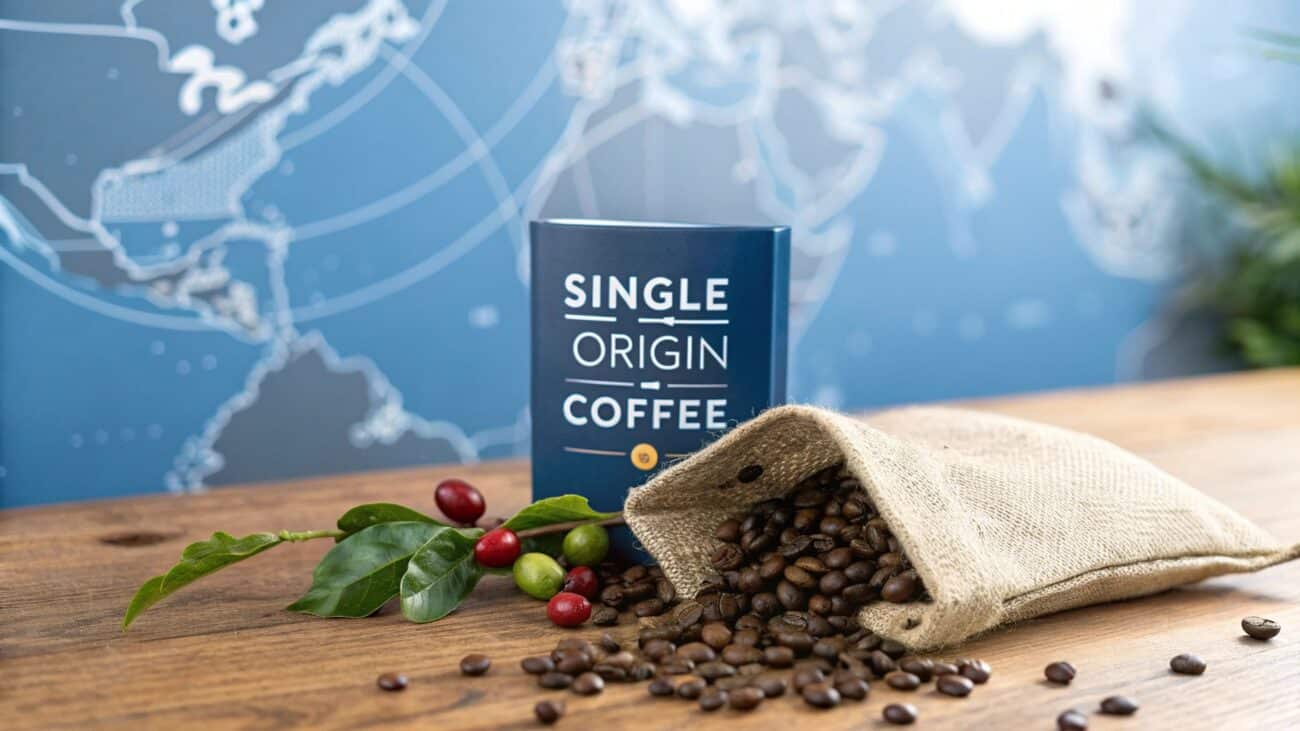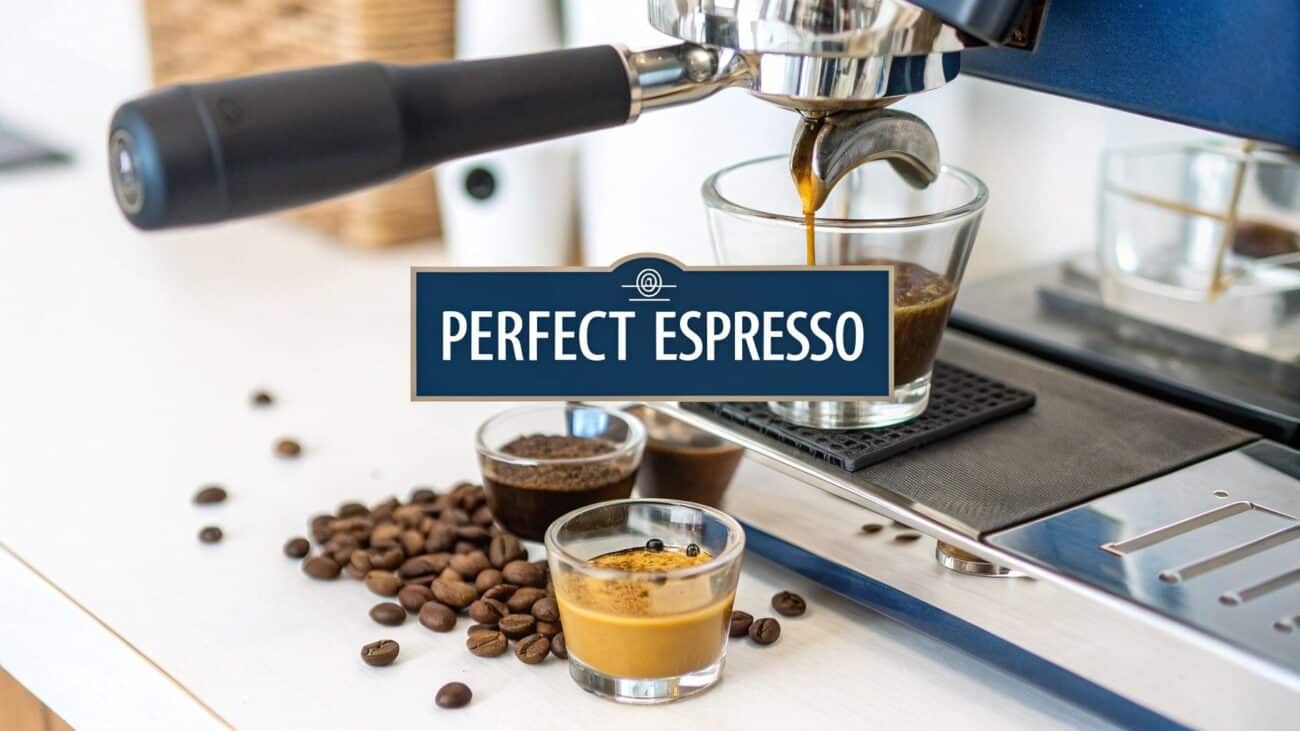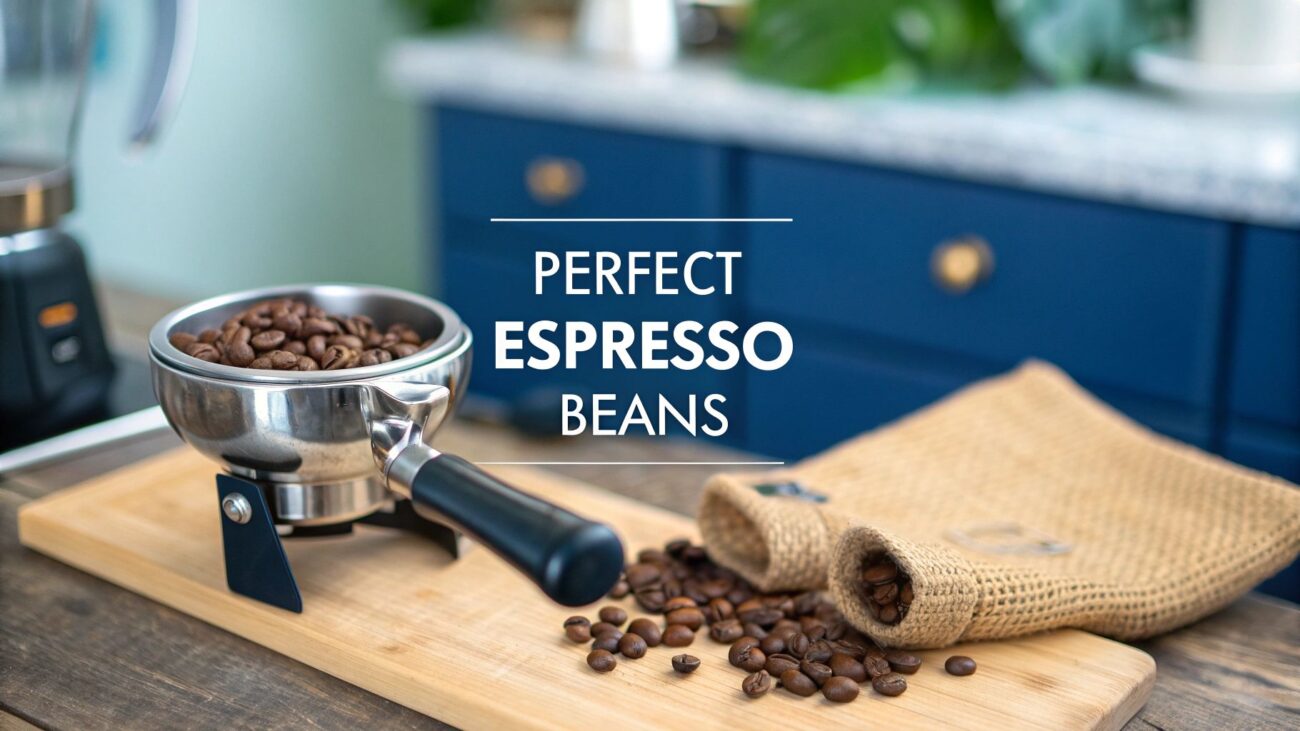Finding the Best Beans for Espresso Coffee
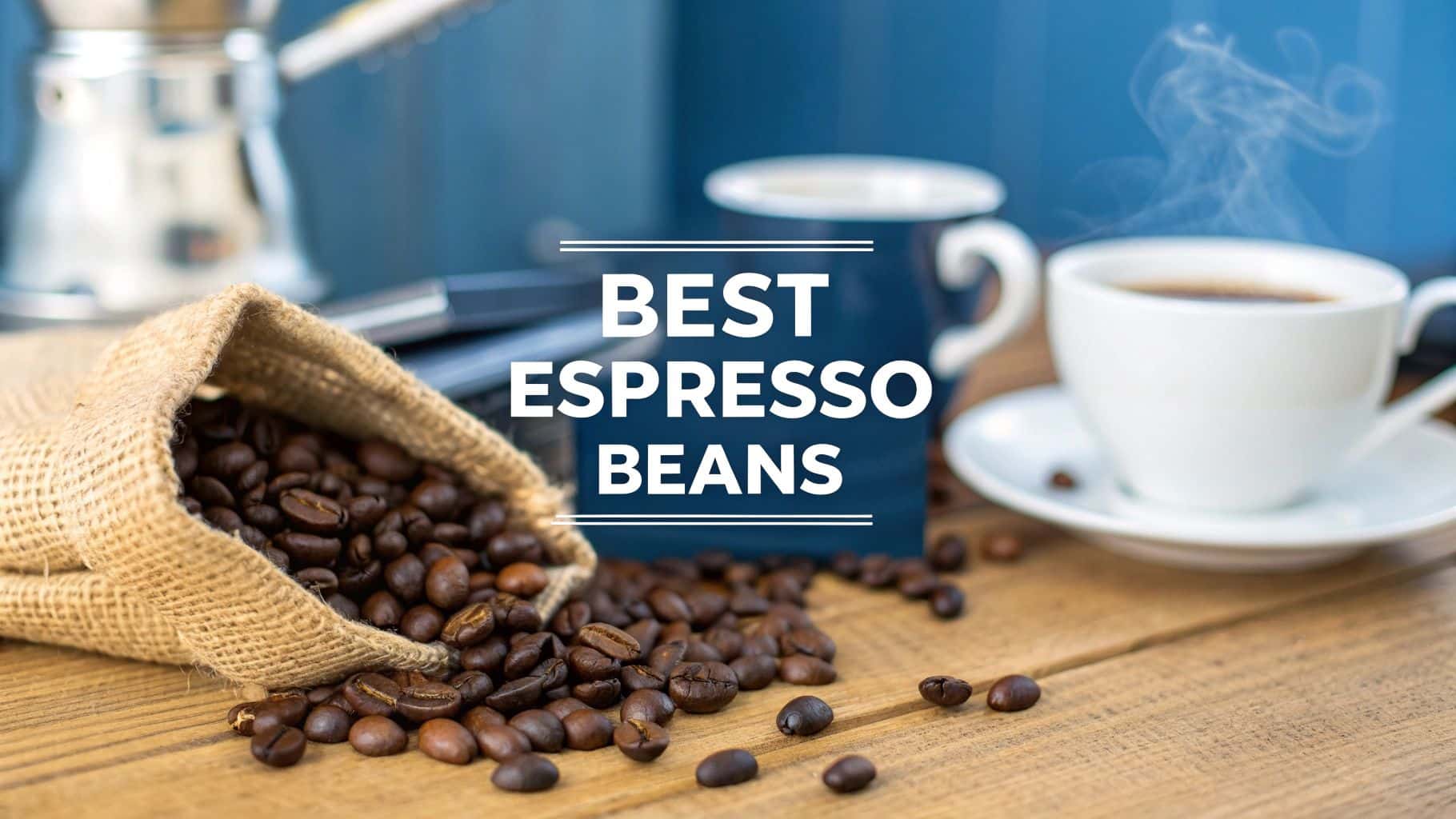
Finding the best beans for an espresso is about more than just grabbing a bag off the shelf. Think of it as the first, most crucial step on the journey to that perfect shot. While a fresh, medium to dark roast is a great starting point, the real magic lies in the details.
For those silky-smooth, complex flavours, a 100% Arabica bean is a fantastic choice. If you’re chasing that classic, bold Italian taste with a thick, stable crema, you'll want a blend that includes a bit of Robusta.
Your Guide to the Perfect Espresso Shot
The search for a truly exceptional espresso begins long before hot, pressurised water ever touches the coffee grounds. It starts with the bean itself—a tiny seed packed with potential, its final flavour shaped by where it was grown, how it was roasted, and the way you prepare it.
Getting to grips with these core elements is what separates a generic, forgettable coffee from a cup that genuinely sings to your palate.
Think of choosing coffee beans like a chef sourcing ingredients for a signature dish. A great chef knows the origin of their produce matters, and the same is true for coffee. The soil, the altitude, and the climate all leave a unique fingerprint on the final taste. The roast is the "cooking" phase, where a skilled roaster carefully develops sweetness, body, and acidity to create a profile that’s just right for espresso.
What Makes Espresso Beans Different?
Technically, you can use any coffee bean to make an espresso. But not all beans are up to the task. The high-pressure extraction of an espresso machine is like a magnifying glass—it amplifies everything, the good and the bad. This is why certain qualities are non-negotiable.
- Balanced Acidity: Light roasts often have a sharp, bright acidity. When pulled as an espresso, this can easily turn unpleasantly sour. Medium to dark roasts are your friend here, as they mellow out that acidity and bring forward deeper notes of chocolate, nuts, and caramel.
- Good Body and Crema: The oils that develop during the roasting process are vital. They create that thick, syrupy body and the iconic reddish-brown crema that crowns a well-pulled shot.
- Solubility: An espresso shot is pulled in just 25-30 seconds. The beans need to be roasted in a way that allows their flavours to dissolve easily and evenly within that tiny window of time.
The secret to a great espresso lies in harmony. It's the artful balance of sweetness, acidity, and bitterness that creates a shot you'll want to savour. Achieving this starts with selecting the right raw material—the coffee bean.
Once you’ve found the right beans, mastering the brew is the next adventure. Learning how to make espresso at home is a rewarding experience, and this guide will give you the confidence to pick the perfect beans for your machine and taste.
To simplify your search, here's a quick overview of the critical variables that shape the quality and flavour of your espresso.
Key Factors for Choosing Espresso Beans
| Variable | Impact on Espresso | What to Look For |
|---|---|---|
| Origin | Influences core flavour notes (e.g., fruity, earthy, floral). | Look for regions known for balanced profiles, like Brazil or Colombia. |
| Roast Profile | Determines sweetness, acidity, and body. | Medium to dark roasts are ideal for reducing sharpness and enhancing richness. |
| Bean Variety | Arabica offers complexity; Robusta provides crema and boldness. | A 100% Arabica for nuanced flavours or a blend for a classic, punchy shot. |
| Freshness | Freshly roasted beans retain volatile oils essential for crema and aroma. | Always check the roast date on the bag. Aim for beans roasted 7-21 days ago. |
| Grind Size | Critical for proper extraction. Too fine leads to bitterness; too coarse is sour. | A fine, consistent grind is necessary. Best achieved with a quality burr grinder. |
Understanding these factors empowers you to move beyond simply buying "espresso beans" and start choosing coffee that truly matches what you love in a cup.
How Bean Origin Shapes Your Coffee's Flavour
Just like grapes grown for fine wine, coffee beans are a direct reflection of their environment. The soil, altitude, and climate where they're cultivated—what the experts call terroir—impart a unique and distinct flavour profile into every single bean. This is why getting to grips with a coffee's origin is your first step to finding beans that truly hit the mark.
Think of the world's main coffee-growing regions as distinct culinary styles. Each one offers a signature set of flavours, making it easy to predict what you might find in the cup once you know where the beans came from. This little bit of knowledge empowers you to explore coffees with confidence, knowing what to expect from a bag of beans from Brazil versus one from Ethiopia.
Latin American Coffees
Latin America is often considered the heartland of classic, crowd-pleasing coffee flavours. If you enjoy a balanced, smooth, and familiar cup that just feels like a proper coffee, this is the perfect region to explore.
- Flavour Profile: Expect notes of chocolate, nuts, and caramel, often with a mild acidity and a full, satisfying body. These coffees are renowned for their consistency and balance.
- Key Origins: Brazil and Colombia are the titans of this region. Brazilian beans are typically nutty and low in acidity, forming the backbone of many classic espresso blends. Colombian coffees often add a touch of fruity sweetness and a brighter character.
The UK's love for these balanced flavours is clear; we import over one billion British pounds worth of coffee annually, with a huge chunk coming from producers like Brazil. These imports are crucial for supplying the high-quality Arabica needed for our vibrant espresso scene.
African Coffees
For those who fancy a more adventurous and aromatic experience, African coffees offer a dazzling spectrum of bright and complex flavours. These beans are celebrated for their vibrant, often surprising character.
Think of African coffees as the vibrant, aromatic spices in the culinary world. They are known for their bright, fruity, and floral notes that can range from the delicate scent of jasmine to the sweet burst of fresh berries.
Beans from this continent, particularly single-origin coffees, are prized for their unique and expressive qualities. If you’re keen to dive deeper, you can learn more about what makes single-origin coffee special in our detailed guide.
Asian Coffees
Asian coffees bring a completely different character to the table, often described as bold, deep, and complex. These beans are perfect for those who enjoy a rich, powerful, and unconventional espresso.
- Flavour Profile: Look for deep, earthy notes, hints of dark chocolate, and sometimes a touch of spice or smokiness. They often have a heavy body and very low acidity.
- Key Origins: Indonesia, especially the island of Sumatra, is famous for producing these distinctive, full-bodied coffees that provide an intense and memorable espresso experience.
Why the Roast Profile Is So Important
Roasting is where the magic really happens. It’s the process that takes a dense, grassy-smelling green bean and transforms it into the brittle, aromatic, and flavourful coffee bean we all recognise. Think of a roaster as a chef and the green bean as a raw ingredient. It’s a lot like toasting bread: a light touch preserves the grain’s natural character, whereas a darker toast develops those deep, smoky flavours. For espresso, this "cooking" stage is absolutely critical.
The intense pressure of an espresso machine is like a magnifying glass, amplifying every single characteristic of the bean. A roast that isn’t optimised for this specific brewing method will have its flaws exposed immediately. Beans roasted too lightly often pull a shot that’s aggressively acidic and sharp—sometimes unpleasantly sour—because their internal structure hasn't developed enough for a quick, high-pressure extraction to work its magic.
Finding the Espresso Sweet Spot
On the flip side, very dark roasts can give you that classic, bold espresso taste, but they walk a very fine line. It is incredibly easy for them to become overwhelmingly bitter, oily, and burnt-tasting, completely masking the nuanced flavours of the bean’s origin. Push the roast too far, and the natural sugars inside the bean taste more like ash than delicious caramel.
This is exactly why the "sweet spot" for espresso is widely considered to be a medium to medium-dark roast. This level of roasting strikes the perfect harmony.
A medium to medium-dark roast expertly balances the three core pillars of a great espresso shot: sweetness, body, and acidity. It mellows the sharp acids found in lighter roasts while fully developing the sugars and oils needed for a rich, syrupy texture and a beautiful, stable crema.
This infographic shows just how much the roast level impacts the acidity you taste in the final cup.
As you can see, acidity drops off significantly as the roast gets darker, which is a key part of achieving a smooth, balanced espresso shot.
How Roasting Creates Espresso Flavours
During the roasting process, hundreds of chemical reactions are firing off inside the bean. One of the most important is the Maillard reaction—the very same process that gives browned food its distinctive flavour. Here’s a quick look at what’s going on:
- Sugar Caramelisation: The natural sugars in the bean begin to caramelise, creating the deep, sweet notes of toffee, chocolate, and caramel that we all love in a good espresso.
- Oil Migration: As the bean's internal structure breaks down, oils migrate towards the surface. These oils are absolutely essential for creating a rich body and that thick, lasting crema that sits proudly on top of a perfect shot.
- Acidity Reduction: The longer a bean roasts, the more its bright, citric acids are muted. This leads to a smoother, more rounded flavour profile that is perfectly suited for espresso.
Getting to grips with the subtleties of roasting can completely change your coffee experience. To dive deeper into this, we highly recommend reading our detailed guide on how different coffee roasting profiles work. Choosing the right roast isn’t just about preference; it's the foundational step toward consistently pulling delicious, well-balanced shots of espresso at home.
Choosing Between Arabica and Robusta Beans
As you dive into the world of espresso, you’ll quickly meet the two main players in the coffee game: Arabica and Robusta. These are the two most popular species of coffee tree, and getting to know their distinct personalities is the first step to finding beans that will sing in your espresso machine.
Think of it like choosing between a fine wine and a bold liqueur. One offers delicate complexity and aromatic elegance, while the other delivers a powerful, punchy experience. Neither is automatically "better"—they just serve different purposes, especially when put under the intense pressure of an espresso machine.
The Refined Character of Arabica
Arabica is the undisputed star of the speciality coffee scene, celebrated for its nuanced and aromatic qualities. It's the bean behind those bright, fruity single-origin shots you’ll find in a third-wave coffee shop.
Grown at high altitudes, Arabica beans are trickier and more expensive to cultivate. This delicate upbringing results in a coffee with higher acidity and a vast spectrum of complex flavours, from floral and sweet to wine-like and fruity. For a smooth, sophisticated shot that highlights the subtle notes of a coffee's origin, 100% Arabica is the way to go.
Coffee Arabica holds the majority of the coffee bean revenue share in espresso products globally. This preference is strongly reflected in the UK, where its smoother, more complex flavour profile is highly valued. Find out more about UK coffee market trends on Statista.
The Bold Power of Robusta
Robusta, just as its name suggests, is a hardier and more resilient plant. It packs a serious punch, containing almost double the caffeine of Arabica. But its role in espresso goes far beyond just a jolt of energy.
This powerhouse bean is the secret ingredient behind the thick, stable, and long-lasting crema that defines a classic Italian-style espresso. Its flavour profile is deep and bold, with notes of dark chocolate, nuts, and a characteristic bitterness that many coffee lovers actively seek out.
While a 100% Robusta espresso is rare and often too harsh for most palates, a small amount blended with Arabica can work wonders. Robusta adds body, richness, and that all-important crema, creating a more traditional and intense espresso experience that cuts through milk beautifully in a flat white or cappuccino.
Finding The Perfect Blend
So, which should you choose? The beauty of espresso is that you don't have to pick just one. Many of the world’s most beloved espresso coffees are not pure Arabica, but a carefully crafted blend. Roasters expertly combine the two to create a balanced, well-rounded coffee that takes the best qualities from each.
To help you decide what might work best for you, here’s a direct comparison of the two main coffee species.
Arabica vs Robusta for Espresso
| Attribute | Arabica | Robusta |
|---|---|---|
| Flavour | Sweet, soft, with notes of fruit, flowers, and sugar. | Strong, bold, with notes of dark chocolate and nuts. |
| Acidity | Higher and more complex. | Lower and less pronounced. |
| Caffeine | Lower (around 1.5% by weight). | Higher (around 2.5% or more by weight). |
| Crema | Thinner, lighter-coloured, and less stable crema. | Thick, dark brown, and very stable crema. |
| Best For | Smooth, nuanced espresso shots and Americanos. | Creating a classic Italian-style espresso with a rich crema. |
Ultimately, your choice comes down to personal taste. Do you want a delicate, aromatic shot that lets you taste the subtle notes of its origin? Go for a 100% Arabica. Or do you prefer a strong, classic brew with a thick crema that stands up to milk? A blend with 10-20% Robusta will be your best bet.
How Processing Methods Create Different Tastes
Long before a bean ever meets a roaster, a critical decision is made back at the farm that completely alters its final flavour. This is processing, the all-important step where the coffee bean is separated from the fruit that surrounds it—the coffee cherry.
Think of it like preparing fruit. You could peel and wash an apple for a clean, crisp taste, or you could dry it whole to concentrate its sweetness, creating something much richer. It’s the same principle with coffee, and knowing the difference gives you a massive advantage in finding the best beans for your espresso machine.
Each method stamps a distinct character onto the bean, shaping everything from sweetness and acidity to its body and aroma. Getting your head around the three main methods will help you predict a coffee's personality before you've even opened the bag.
The Washed Method: Clean and Crisp Flavours
The washed (or wet) process is all about purity. In this method, the fruit pulp is completely washed away from the bean before it gets a chance to dry.
To go back to our fruit analogy, this is like rinsing freshly picked berries. The goal is to strip away any external influences, so the final flavour is a true expression of the bean itself and the terroir where it was grown.
This results in coffees with a remarkably clean, crisp profile, often sparkling with bright acidity and delicate floral or citrus notes. If you love a vibrant, articulate espresso where the origin characteristics really sing, you should look for washed coffees from places like Colombia or Kenya.
The Natural Method: Sweet and Fruity Flavours
The natural (or dry) process is the oldest and most traditional way of doing things. Here, the entire coffee cherry is left intact and dried in the sun, almost exactly like making raisins from grapes.
Over a drying period that can take weeks, all the sugars and fruity flavours from the pulp get absorbed directly into the bean. This creates a coffee with a completely different personality—one that’s heavy-bodied, intensely sweet, and brimming with jammy, wine-like notes.
Naturally processed beans are prized for their bold, complex, and sometimes wild flavour profiles. Expect notes of strawberry, blueberry, and tropical fruit, with a lower acidity and a syrupy texture that makes for a rich and memorable espresso.
These beans, especially high-quality single-origin coffees, offer a world of flavour to explore.
The Honey Method: The Perfect Balance
Sitting beautifully between washed and natural is the honey (or semi-washed) process. The skin of the cherry is removed, but a specific amount of the sticky, honey-like pulp (known as mucilage) is left clinging to the bean as it dries.
This method gives you the best of both worlds. You get some of the deep sweetness and fruitiness of a natural coffee, but it’s paired with the clean finish and balanced acidity of a washed coffee. The amount of pulp left behind creates a whole spectrum of flavours, from bright and zesty to deep and syrupy.
Putting It All Together for the Perfect Brew
Nailing down the perfect origin, roast profile, and processing method gets you most of the way there, but a few final details can make or break your espresso. Think of these as the practical steps that ensure all that incredible flavour you've chosen actually ends up in your cup.
First up, and arguably most important, is freshness. Coffee isn’t a pantry staple you can forget about for months; it’s a fresh product, and its best aromas and flavours start to diminish surprisingly quickly after roasting. Always check the bag for a ‘roasted on’ date. This is far more revealing than a ‘best before’ date because the flavour sweet spot is usually between seven and 21 days after roasting.
The Make-or-Break Role of Grind and Ethics
While this guide is all about whole beans, we can't ignore what happens next. How you grind those beans is absolutely non-negotiable for good espresso. The grind needs to be incredibly fine and consistent, allowing the pressurised water to extract all that beautiful flavour evenly in just 25-30 seconds. A grind that's even slightly off is a surefire recipe for a disappointing, unbalanced shot.
To really get this right, you need to understand how particle size impacts extraction. It’s a science in itself, which is why we’ve put together a comprehensive coffee grind size guide to walk you through it.
Finally, take a moment to consider the journey your beans have taken. Choosing the best beans for espresso isn’t just about what’s happening in your cup; it's also about the impact that cup has on the world.
Sustainability and ethical sourcing are more than just buzzwords—they are genuine indicators of quality. Beans grown with care for the environment and fairness for farmers nearly always result in a superior product. It's a win-win for everyone, from the farm right through to your cup.
Look for certifications that tell you a bit more about the coffee's story:
- Fair Trade: This certification guarantees that farmers receive a fair, stable price for their coffee. It empowers them to invest in their communities and adopt more sustainable farming practices.
- Direct Trade: This is where roasters buy directly from farmers, often paying a premium well above market rates. It fosters strong, lasting relationships and encourages exceptionally high-quality cultivation.
By paying attention to these final details—freshness, grind, and sustainability—you're not just brewing better coffee. You're making smarter, more conscious choices that get the most out of every single bean.
Got Questions About Espresso Beans? We've Got Answers
Stepping into the world of espresso often brings up a few common questions. Don't worry, we've heard them all. Here are some straightforward, no-nonsense answers to help you choose the perfect beans for your espresso machine and brew with total confidence.
Can I Use Just Any Coffee Beans for Espresso?
Technically, yes, you can throw any coffee bean into your machine. But should you? That's another story. Not all beans are created equal, and most aren't cut out for the intense, high-pressure world of espresso brewing.
Beans roasted specifically for espresso, usually a well-balanced medium-dark blend, are far more forgiving. They're designed to produce that rich, syrupy shot with a stable, beautiful crema we're all chasing. If you try to use a very light roast, for example, you'll likely end up with a disappointingly sour, thin-tasting shot that lacks body. Stick with beans labelled for espresso to get the best results.
So, Is Italian Espresso Just… Better?
When people talk about "Italian espresso," they're referring to a classic style, not necessarily a superior bean. This style typically involves a clever blend of Arabica and Robusta beans, roasted dark to create a bold, intense flavour with next to no acidity and a thick, long-lasting crema.
If you love that powerful, classic taste you find at coffee chains like Costa or Starbucks, then an Italian-style espresso blend is probably right up your alley. It all comes down to what you enjoy.
The "best" espresso is completely subjective. It's whatever tastes delicious to you, whether that's a bright, zesty single-origin shot or a classic, chocolatey Italian blend.
Should I Bother with Whole Beans or Just Get Pre-Ground?
For the best possible espresso, it has to be whole beans. Every single time. Coffee's incredible flavour and aroma come from delicate, volatile oils that start to vanish the second the bean is ground.
Grinding right before you brew keeps all those wonderful compounds intact, giving you a fresher, more vibrant shot with a much richer crema. Pre-ground coffee might seem convenient, but it simply can't compete with the flavour explosion you get from freshly ground beans.
Quick Answers to Common Espresso Bean Questions
To make things even easier, here's a quick rundown of the most common queries we get about selecting, storing, and brewing the perfect espresso beans.
| Question | Answer |
|---|---|
| What roast is best for espresso? | A medium to medium-dark roast is usually ideal. It offers a great balance of sweetness, body, and acidity, and is forgiving enough for home machines. |
| How long do espresso beans last? | Unopened, they're best within a month of the roast date. Once opened, aim to use them within 2 weeks for peak freshness. Keep them in an airtight container. |
| Is Arabica or Robusta better for espresso? | It's a matter of taste! 100% Arabica gives you smoother, more nuanced flavours. Blends with Robusta add a powerful caffeine kick and a thicker, more stable crema. |
| Why does my espresso taste sour? | This is usually a sign of under-extraction. Your grind might be too coarse, or your brew time too short. Try a finer grind to slow the shot down. |
| Can I use espresso beans for other brew methods? | Absolutely! Espresso-roasted beans work beautifully in a French press or Moka pot, producing a rich, bold cup of coffee. |
Hopefully, that clears a few things up! The journey to the perfect shot is all about experimenting and finding what you love.
Ready to pull your perfect shot? At Seven Sisters Coffee Co, we source and roast exceptional beans designed to bring out the very best in your espresso. Explore our collection of speciality coffee beans today and taste the difference freshness and quality make.

